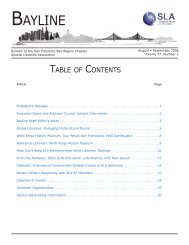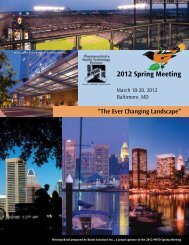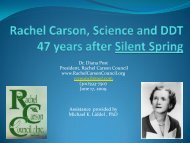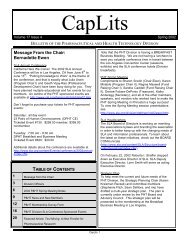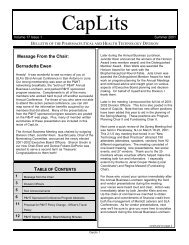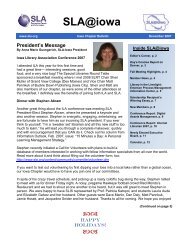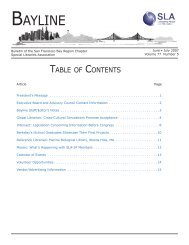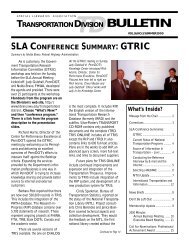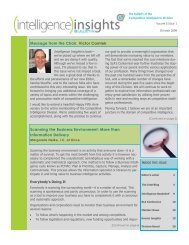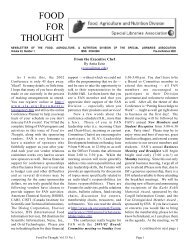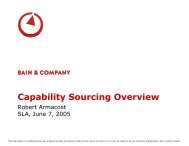Education Libraries - Special Libraries Association
Education Libraries - Special Libraries Association
Education Libraries - Special Libraries Association
You also want an ePaper? Increase the reach of your titles
YUMPU automatically turns print PDFs into web optimized ePapers that Google loves.
Information Literacy<br />
Instruction Handbook<br />
—Reviewed by Barbie<br />
E. Keiser<br />
Cox, Christopher N., and<br />
Lindsay, Elizabeth<br />
Blakesley, eds. (2008).<br />
Information Literacy<br />
Instruction Handbook.<br />
Chicago, IL: <strong>Association</strong><br />
of College and Research<br />
<strong>Libraries</strong>. ISBN: 978-0-<br />
8389-0963-8. $40.00<br />
Information Literacy Instruction Handbook edited by<br />
Christopher N. Cox and Elizabeth Blakesley Lindsay<br />
begins with a decent background essay on the evolution<br />
of information literacy through the 20 th Century,<br />
followed by a number of chapters that focus on how to<br />
teach—the subject just happens to be information<br />
literacy. Around Chapter 5, “Curriculum Issues in<br />
Information Literacy Instruction” by Barbara Fister and<br />
Thomas W. Eland, the volume takes on the specificity<br />
this subject deserves. Ms. Fister begins by placing<br />
information literacy within the broader context of<br />
knowledge production, sharing, and use. She presents<br />
various approaches for integrating information literacy<br />
into curricula, such as first year experience, courserelated<br />
instruction on demand, sequenced instruction,<br />
team-teaching, faculty development, and creating a<br />
learning commons.<br />
Thomas Eland continues the curriculum-integrated<br />
approach by focusing on the desired outcome of the<br />
information literacy program before it is developed,<br />
describing what is needed to build a sustainable,<br />
comprehensive information literacy program. He uses a<br />
curriculum-based information literacy program at the<br />
Minneapolis Community and Technical College as an<br />
interesting model that goes beyond the acquisition of<br />
research skills, asking more reflective questions about<br />
information such as:<br />
� “Who owns and sells knowledge?”<br />
� “Who has access to information?”<br />
� “What counts as information (or<br />
knowledge)?”<br />
� “Whose voices get published/do not get<br />
published?”<br />
The book continues with chapters concerning program<br />
management, leadership and student academic integrity.<br />
My two favorite chapters focus on “Instruction and<br />
Program Design through Assessment” by Debra<br />
Gilchrist and Anne Zald and “Instructional<br />
Technologies” by Stephen J. Bell, John D. Shank and<br />
Greg Szczyrbak. “Instruction and Program Design<br />
through Assessment” discusses four learning outcomes.<br />
The authors ask five questions, and then present ideas as<br />
to what you can reasonably expect to accomplish within<br />
1-2 class periods vs. outcomes for a credit-bearing<br />
course within one discipline that can then take on a<br />
broader context:<br />
1. What do you want the student to be able to do?<br />
(Outcome)<br />
2. What does the student need to know in order to<br />
do this well? (Information Literacy Curriculum)<br />
3. What type of instruction will best enable the<br />
learning? (Pedagogy)<br />
4. How will the student demonstrate the learning?<br />
(Assessment)<br />
5. How will I know the student has done this well?<br />
(Criteria for Evaluation)<br />
Gilchrist and Zald help the librarian through the process<br />
of designing learning outcomes and present options for<br />
alternative types of assessment to ascertain whether the<br />
learner has absorbed what has been taught: formal,<br />
informal, authentic, integrated, knowledge/contentbased,<br />
formative, summative, self-assessment, and<br />
progressive and/or developmental. The authors offer<br />
criteria to guide the librarian teacher in the development<br />
and quality assessments that apply not only to the<br />
learner, but the program itself.<br />
Bell, Shank, and Szczyrbak focus on an instructional<br />
systems design model known as ADDIE:<br />
� Analysis – the process of defining what is to<br />
be learned<br />
� Design – the process of specifying how it is<br />
to be learned<br />
� Development – the process of authoring and<br />
producing learning materials<br />
� Implementation – the process of installing<br />
the instruction product in a real world<br />
context<br />
� Evaluation – the process of determining the<br />
impact of the instruction.<br />
They encourage experimenting with new technologies,<br />
overcoming the resistance that may be encountered<br />
along the way by various parties. They provide examples<br />
<strong>Education</strong> <strong>Libraries</strong>, Volume 31, No. 2, Winter 2008 47



